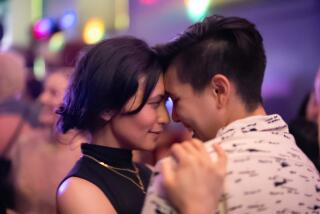MOVIE REVIEW : Incisive Look at Lesbian Social Revolution
- Share via
Paris Poirier’s “Last Call at Maud’s” (at the Sunset 5) at once bids a fond farewell to a cherished San Francisco landmark and documents a social revolution. Warm without being overly sentimental, this consistently entertaining and engaging film invites its interviewees to range far beyond barroom reminiscences to tell us what it was like to be a lesbian in postwar America. As a filmmaker Poirier is as focused as she is informative, for “Last Call at Maud’s” is both incisive and comprehensive in its mere 75 minutes, drawing upon a treasure trove of stills and home movies.
Opening in April, 1966, in the Haight Ashbury district and closing in September, 1989, it may well have been the longest-running women’s bar in the world, as its owner Rikki Streicher and her friends believe. Unpretentious in its decor as any neighborhood bar, Maud’s was clearly a friendly spot from the start at a time when lesbians, like gay males, had virtually no alternatives to bars as meeting places.
For a number of years after Maud’s opened Streicher had constantly to be on the alert for vice raids, couldn’t hire women as bartenders until 1973 and, for several years beyond that, was vulnerable to being shut down if the police caught a woman so much as touching another woman’s shoulder. Not until the latter part of the ‘70s were gay and lesbian bars free from harassment, says one of Maud’s longtime customers--even in San Francisco.
Interestingly, Maud’s customers suggest strongly that lesbian bars have always been a great deal more democratic and inclusive than gay male bars, many of which have been blatantly racist and ageist in their admission policies.
Two of Maud’s best-known patrons in its earlier years were Del Martin and Phyllis Lyon, pioneering lesbian activists, lovers for 40 years and founders in 1955 of the Daughters of Bilitis, the first major lesbian organization. They and others talk of the incredible secrecy in which gay men and women had to live their lives in the conservative ‘50s. Streicher tells us that when she opened the bar bouffant hairstyles were in full force, soon to be swept away in the impact of the hippie invasion that flowered famously in Haight Ashbury itself, affecting not only the way lesbians looked but also the way they thought and felt about themselves and each other.
Indeed, Poirier excels in encouraging her subjects to explain how changes in American society at large transformed the lesbian community in particular--from involvement in the anti-war and women’s movements as well as gay liberation to the AIDS epidemic of the past 12 years. AIDS, in fact, is cited as one of the numerous reasons contributing to the demise of Maud’s. Soaring overhead costs and declining business did Maud’s in, but the underlying causes, along with more conservative sexual behavior dictated by AIDS, seem to include a growing trend toward sobriety and people being more “into themselves,” as one woman puts it. As much as it surely has been missed by its regulars, Maud’s may simply have outlived its usefulness, for as one woman points out, there are now many places for a lesbian to be public about her sexual orientation. Even so, you can’t help but suspect the loss of Maud’s reflects the loss of sense of community that permeates so much of American society today. (Times-rated Mature for adult themes, suitable for teen-agers.)
‘Last Call at Maud’s’
A Maud’s Project presentation. Producers Paris Poirier, Karen Kiss. Director-editor Poirier. Cinematographer Cheryl Rosenthal. Sound Lauretta Molitor. Running time: 1 hour, 15 minutes.
Times-rated Mature (for adult themes, suitable for teen-agers).
More to Read
Only good movies
Get the Indie Focus newsletter, Mark Olsen's weekly guide to the world of cinema.
You may occasionally receive promotional content from the Los Angeles Times.









